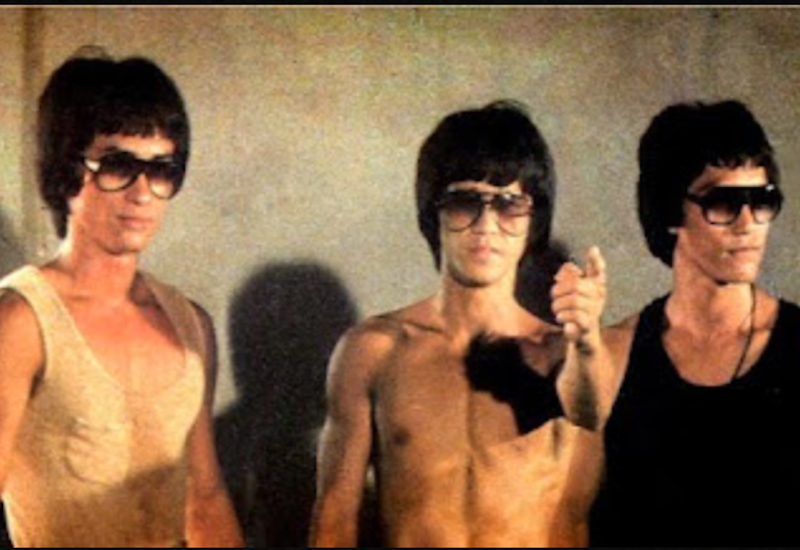On a busy Saturday, I went to a Manhattan lecture by science writer John Horgan on his effort to learn quantum physics, then to the Tribeca Film Festival to see Enter the Clones of Bruce, a documentary about the 1970s “Bruceploitation” cinematic trend that aimed to meet public demand for Bruce Lee films, notwithstanding the martial artist’s death, by offering actors with similar names and looks, playing him or characters he played, and extending his kung fu persona into new plotlines such as fights with vampires. One movie, released in 1980 as the trend was petering out, was about literal Bruce Lee clones. Back in New Jersey on Saturday night, I streamed The Artifice Girl, an absorbing story about an AI.
“The End of Science Is Bullshit!” blared one of Horgan’s slides, which was notable in that he was castigating one of his own books, which claimed that science was facing a dead end, having broadly answered the questions it’s capable of answering. Having now studied the Schrödinger equation, Horgan pointed out this centerpiece of modern physics can’t precisely describe anything more complex than a hydrogen atom; it needs approximations even for dealing with a helium atom. He also expressed optimism that quantum computing will open new frontiers in physics and beyond.
I chatted with Horgan before the lecture; I’ve known him through copyediting and reviewing, but we hadn’t previously met in person. He asked what my background was, and he was hoping some physics types would show up to critique his lecture, but I had to tell him my majors were economics and history, and that I’ve bounced between science journalism and political and financial journalism. Horgan was an English major and until recently hadn’t taken math courses in decades, an outsider’s perspective he’s put to adept use in his recent book My Quantum Experiment and in his science writing more broadly.
I’ve written about Bruce Lee. My article, for National Review two decades ago, titled “Remember the Dragon” and timed for the 30th anniversary of his death, was, in retrospect, bullshit. Watching Enter the Clones of Bruce uncomfortably evoked that old piece’s ersatz nature, in that—reminiscent of the Bruceploitation filmmakers (whom I’d only vague awareness of until now, despite researching Lee’s legacy)—I appropriated the martial artist’s fame for my own agenda. In 2003, that agenda was propounding libertarian-conservative politics, and so, with a mild disclaimer that “We’ll never know what directions his life and career would have taken,” I invented a putative political identity for the martial artist in the article’s obnoxious last line: “Bruce Lee vs. Arnold Schwarzenegger would’ve made a great Republican primary.”
I also mentioned at the time, with unreflective enthusiasm, that a Korean company was working on a movie that would feature a computer-generated version of Lee. I’m not sure what became of that project, but it was a forerunner of the deepfake capabilities that have become available lately and which, along with other AI developments, have brought new fuzziness to the boundaries between real and fake. The Artifice Girl manages to be engaging even though it emphasizes talk over action, and takes place mainly with a handful of characters interacting, over time, in several rooms. The story opens with an interrogation where it seems that an online sexual predator has been caught. The suspect, Gareth (played by writer-director Franklin Ritch), soon shows his interlocutors that things are not what they seem. In particular, the girl whose images they’ve seen on his computer, Cherry (played by Tatum Matthews, in an excellent performance), isn’t a real girl, but an AI designed to lure and catch predators.
Cherry’s capabilities are growing fast, which raises ethical quandaries without veering predictably into the well-worn sci-fi groove of an AI deciding to terminate its controllers. The prospect of bringing Cherry into the physical world, through an android body she can inhabit, complicates things further. The possibility that she might live for a long time, far beyond the span of any human, is also entangled with questions of what her proper goals in life might be, and how and by whom these should be decided.
In the real world, anxiety about AI has arisen, in significant part, from the capacity of AIs to spread misinformation (both at the behest of human propagandists and through unrequested “hallucinations” to which chatbots are known to be prone). While these are serious problems, I suspect the technology’s prospective negative impact is overstated, through a misestimation of the baseline; humans will believe all sorts of crazy things, regardless of whether the misinformation comes from AIs. The Bruceploitation craze didn’t need any advanced technology to confuse viewers as to whether they were watching the real Bruce or not; some fans didn’t even realize Bruce Lee was a person who’d lived, not a character that filmmakers had created.
One technique that may help separate fact from falsehood is assessing whether a source of information—a journalist, say, or a politician—ever engages in self-criticism. Beware the person who never admits an error, who never looks back and says their earlier statement was an eight-letter word. Also, beware the clones of such people, who parrot the gist of a spreader of lies in hopes of winning that person’s audience.
—Kenneth Silber is author of In DeWitt’s Footsteps: Seeing History on the Erie Canal and posts at Post.News.

